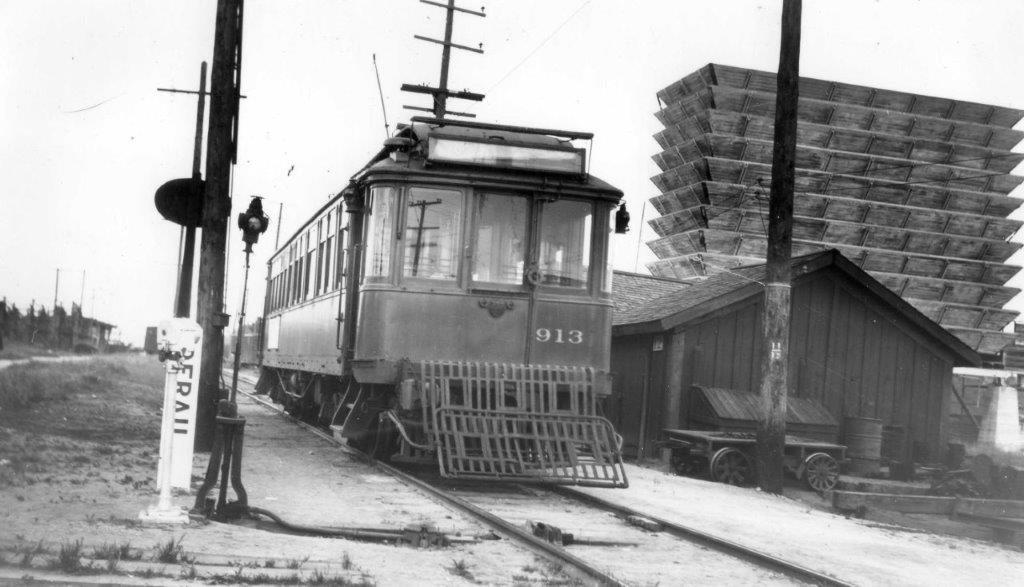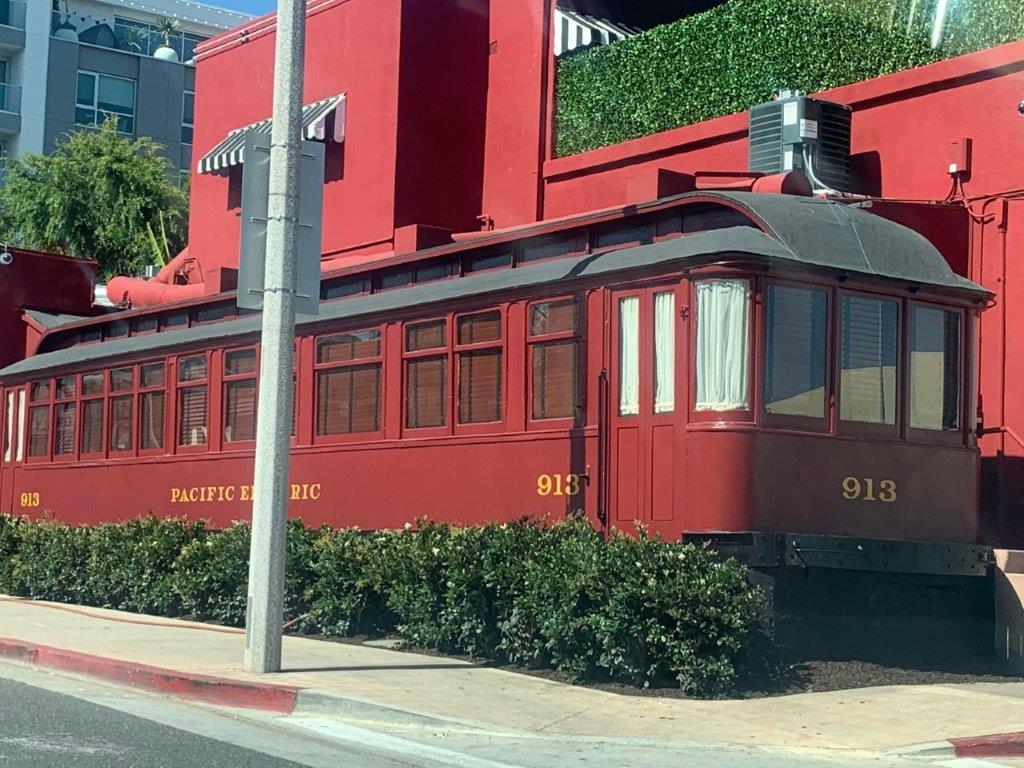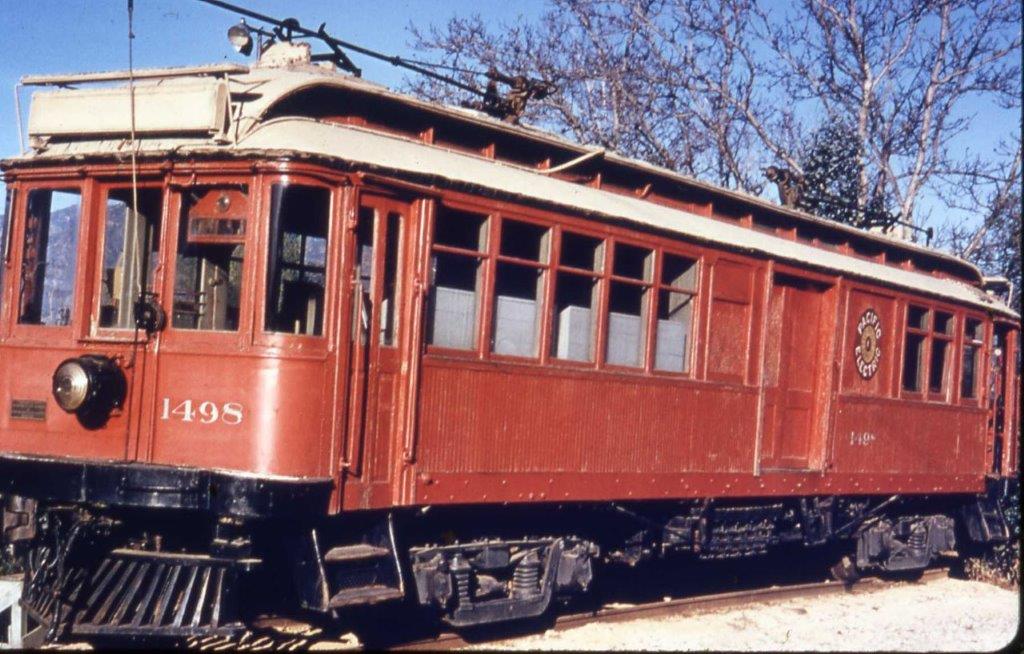Pacific Electric No. 913: The life of a true “survivor” (sort of)
By Ralph Cantos
This photo taken by the late Harold F. Stewart from the Craig Rasmussen Collection shows Pacific Electric No. 913 heading west bound at Culver Junction on the Santa Monica Air Line. It’s mid-1940 and 38 years of dependable service by the 913 is nearing an end. At this date, the 913 is just one of a handful of 800s still in service. By early 1941, they were all gone.
The service life of the 131 800s is legendary in PE history. Built by the St. Louis Car Co. in 5 orders between 1902 and 1906, they were the second-largest class of cars on the PE system, second only to the 159 Hollywood cars (600-758). The 800s were to their last days the fastest interurbans on the PE system, faster than PE’s fantastic San Berdoo 12s. Only Henry Huntington’s private car “Alabama” was faster.
They were also the heaviest wood-bodied cars on the system. As built, almost half of the car body was open to the warn California climate, only a sturdy mesh screen from the floor line, to the belt rail, protected seated passengers. In June 1903, an issue of trade magazine Street Railway Journal although prizing the cars, took issue with the PE for allowing passengers in the open section, to be battered by high winds, as the 800s rolled along the open fields of early Southern California at speeds in access of 70 mph.
It did not take the PE management much effort to get the hint. At first, the mesh screen was replaced by wood paneling from the floor line to the belt rail. But this did little to soften the hurricane-force winds buffeting seated passengers in the still open section. By late 1906, the cars were fully enclosed, ending what could only be described as an early California “thrill ride.”
The PE management must have loved the 800s as they performed several experiments on the cars at one time or another. The 800s were the first cars on the PE to be equipped for MU (multiple unit) operation in 1906-07.
Also, about 1912, cars 912-917 were equipped with high-speed General Electric motors and controls in preparation for ordering the magnificent San Berdoo 12s. These six cars became known as the “GE 8s” and for the rest of the long service life, could only operate with each other. The 6 cars could not operate MU with the rest of the 800s. These 6 cars were the fastest and most powerful 800s on the system.
Strangely enough, the PE did not equip all 800s with MU controls. These cars had couplers for towing, but operated only as single cars. In 1940, as most of the 800s were being scrapped and burned, 4 800s were converted into box motors, numbered 1496-99. One of those cars, 1498 (859) was donated to the children of Los Angeles and placed on display at Travel Town in Griffith Park. There, the 1498 sat out in the open for more than 4 decades with little or no real maintenance to its canvas covered wood roof. Finally, the weight of the two 300-pound air trolley base caused the roof to almost cave in. The 1498 was donated to the Orange Empire Trolley Museum at Perris, but it was destroyed by a fire in the “out back” area where the 1498 was stored.
Today, the body of GE-8 913 remains the lone survivor of the once-magnificent fleet. It is now part of the FORMOSA CAFÉ in West Hollywood where it has resided since its 1941 retirement. Overall, the 913 is in excellent condition. The Formosa Café is a Los Angeles Cultural landmark, so I guess the 913 will be there for all time.









I lived near the Cienega stop on the Air Line and remember Culver Junction well. For the life of me I cannot place that cooling tower. Anybody remember its exact location, and what function it served?
What was the line that ran along Slauson? I am watching crews dismantle ties and rails right now around Slauson and Figueroa 3/8/2021.
No, the Santa Monica airline is the route of the present day Metro Expo (E) line.
The car body at Wilson Park is that of IER BLIMP car #4601. On a foggy morning in 1946, while operating as the TORRANCE SHOP TRAIN, it collided head on with PE Juice Jack #1628. The motorman was killed and several PE shop men were badly injured. The body of damaged #4601 was purchased by a private party and used as part of a house in the city of Torrance. Years ago, when the house was being demolished, the body of the 4601 was discovered to the surprise of just about everyone. The body was moved to Wilson Park. Another IER car became the second 4601.